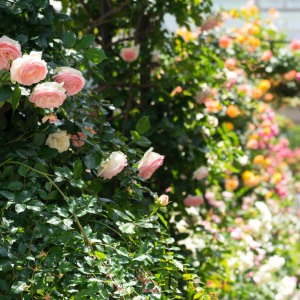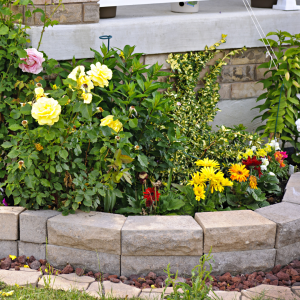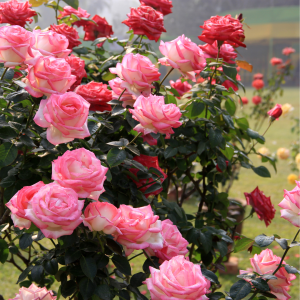The art of companion planting with roses opens up a myriad of benefits and aesthetic delights. This time-honored practice not only enhances the vigor and health of your roses but also turns your garden into a vibrant tableau that is as functional as it is beautiful. By carefully selecting the right companions, gardeners can boost their rose garden’s growth, naturally manage pests, and elevate the visual appeal of their space. The strategic pairing of roses with compatible plants can create a symbiotic environment, where each species thrives and contributes to a more robust garden ecosystem. This introduction to companion planting will explore how combining roses with the right floral partners can transform your garden into a lush, thriving haven.
 Understanding Roses
Understanding Roses
Roses are celebrated for their diversity and beauty, coming in various types that cater to different gardening needs and styles. Hybrid tea roses are renowned for their large, singular blooms and are often the stars of the show in cut-flower gardens. Floribundas, known for their bountiful clusters of flowers, provide continuous color and are ideal for borders and beds. Climbing roses, with their ability to scale walls and trellises, add a vertical dimension to gardens, creating dramatic floral displays.
When planting roses, several key considerations ensure their health and beauty. Sunlight is crucial; roses generally require at least six hours of direct sun per day to thrive. Soil conditions also play a significant role; well-draining soil enriched with organic matter offers the best support for rose roots, promoting vigorous growth. Adjusting these factors according to the specific needs of the rose type chosen can lead to a thriving garden, full of vibrant blooms and healthy foliage.
Benefits of Companion Planting
Companion planting brings a wealth of benefits to rose gardens, enhancing their vitality and resilience. One key advantage is natural pest and disease control. Plants such as marigolds and garlic can repel common rose pests like aphids and nematodes, while others attract beneficial insects that prey on harmful bugs. This natural balance reduces the need for chemical interventions, promoting a healthier ecosystem.
Moreover, companion planting contributes to pollination and biodiversity. Certain plants, like lavender and daisies, attract bees, butterflies, and other pollinators, enhancing the reproductive success of roses and other flowering plants. This variety of flora and fauna creates a more diverse garden ecosystem, fostering a balanced and vibrant environment where roses and their companions can thrive.
Choosing the Right Companions
Choosing the right companions for roses involves careful consideration to ensure that both the roses and their neighboring plants thrive. Key criteria include selecting plants with non-competitive root systems and those that have similar water and light requirements. This ensures that the companions coexist harmoniously, without outcompeting the roses for essential nutrients and resources.
Among the best floral companions for roses are alliums, marigolds, and geraniums. Alliums, with their tall, spherical blooms, not only add a striking visual contrast but also deter pests such as aphids and protect roses with their strong scent. Marigolds are another excellent choice; their bright flowers are not only aesthetically pleasing but also repel nematodes and other pests through the natural chemicals they release into the soil. Geraniums, known for their robust growth and vibrant flowers, help to keep beetles and other leaf-eating insects at bay while adding a splash of color that complements the rose blooms.
However, it’s also important to be aware of plants that should be avoided when planting near roses. Plants that are highly invasive or aggressive can overwhelm the roses, robbing them of essential sunlight, nutrients, and water. By selecting the right companions, gardeners can enhance their rose garden’s health and beauty, creating a flourishing and pest-resistant environment.
Designing Your Rose Garden
Designing your rose garden thoughtfully is key to achieving a harmonious balance between aesthetics and the health of your plants. When planning the layout, consider the mature sizes of both the roses and their companion plants. Arrange them so each plant has ample space to grow without overshadowing its neighbors, allowing for optimal air circulation and sunlight penetration. This arrangement will help prevent disease while enhancing the garden’s visual appeal.
For seasonal considerations, select companion plants that offer staggered blooming periods to ensure your garden remains vibrant throughout the year. Incorporating evergreen plants or those with interesting foliage can also maintain visual interest even when the roses are not in bloom. This strategy not only keeps the garden attractive across seasons but also supports a continuous habitat for beneficial insects and pollinators.
Practical gardening tips like proper mulching, spacing, and timing of planting are crucial. Mulch helps maintain soil moisture and temperature, suppresses weeds, and adds organic matter as it decomposes. When spacing plants, take into account their growth habits and sizes at maturity to avoid overcrowding. Finally, timing your planting can be critical; for many regions, planting roses in early spring or late autumn allows roots to establish before the extremes of summer heat or winter cold. These practical steps are essential for creating and maintaining a healthy, thriving rose garden.
 Maintenance Tips
Maintenance Tips
Maintaining a rose garden with companion plants involves consistent care to ensure both the roses and their companions thrive. Pruning is critical; for roses, regular pruning helps shape the plants, encourages healthy growth, and increases air circulation, which reduces the risk of fungal diseases. Companion plants may also need pruning to prevent them from overshadowing the roses or encroaching on their space.
Feeding is another vital aspect. Roses are heavy feeders and benefit from being fertilized with a balanced, slow-release fertilizer in early spring, just as they begin to leaf out. It’s important to also consider the nutritional needs of the companion plants, which may vary. Some, like marigolds, are low-maintenance, while others might require more specific nutrients.
Watering should be done deeply and infrequently to encourage strong root growth. The best practice is to water the plants at their bases, avoiding wetting the foliage, which can promote disease. Using a drip irrigation system can be highly effective in keeping the plants appropriately hydrated without excess moisture on the leaves.
Addressing common problems in mixed plantings involves vigilance and preventive measures. Pests and diseases can spread quickly in dense plantings, so it’s important to monitor the plants regularly and act swiftly at the first sign of trouble. Implementing integrated pest management (IPM) strategies, such as using disease-resistant plant varieties, encouraging beneficial insects, and removing diseased foliage promptly, can help manage these issues effectively. By following these maintenance tips, gardeners can keep their rose and companion plant garden healthy and flourishing throughout the growing season.
Final Words
In conclusion, creating a rose garden with companion plants offers numerous benefits that extend beyond the stunning visual appeal. This gardening approach enhances plant health, helps in the natural management of pests, and enriches the soil, all while promoting biodiversity. The strategic pairing of roses with complementary companions ensures a robust, vibrant garden ecosystem.
We encourage gardeners of all levels to explore and experiment with different combinations in their gardens. Each plant pairing brings its unique benefits and challenges, offering endless possibilities for customization and creativity. Whether you are a seasoned gardener or a novice, the process of selecting, planting, and nurturing a rose garden with companion plants can be a deeply rewarding experience, full of learning and discovery. Embrace the journey and watch as your garden becomes a thriving haven for both flora and fauna.



